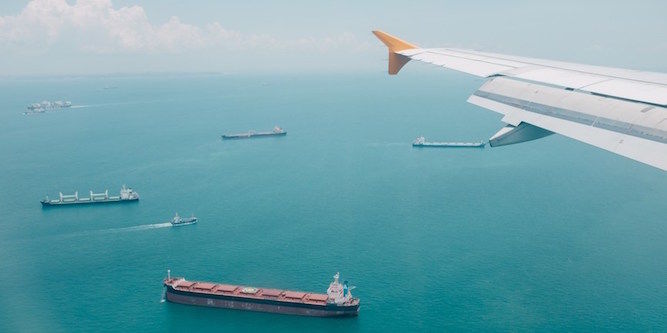
May 5, 2015
Does Apple Ship iPhones by Air or Sea?
Tags:
Does Apple Ship iPhones by Air or Sea?

We all know Apple produces iPhones in China, but how do they ship the phones to the U.S., by air or by ocean?
We estimate that Apple shipped 30M phones to North America just in the fourth quarter of 2014. That’s a lot of freight. The first question in deciding whether to ship by air versus ocean is the relative price of the two services.
Based on the iPhone’s packaging dimensions (15.5 cm x 9 cm x 6 cm, 0.385 kilograms) we estimate that 44,000 phones will fit in a standard 40 foot shipping container before it hits the weight limit. Based on typical market prices and given Apple’s massive purchasing scale, we would expect this to cost about $3,000 per container, all-in including trucking, customs clearance on both sides, terminal fees, fuel surcharges and everything else. That works out to $0.07 per phone.
In general, air freight is around 5 times more expensive than ocean, but that can easily hit 10X during peak season. And we know that the new iPhone is always released during peak season right in the months before Christmas.
That means Apple would have to pay $0.30 to $0.65 more per phone to ship by air instead of ocean. At 30M phones, that’s a difference of $9 – $19.5M per quarter in savings to move the phones by sea. So shipping by ocean is a no brainer right?
Wrong. Apple almost certainly ships by air, despite the higher logistics costs, for two reasons. First is the cost of working capital. Ocean shipments take 30 days or more to cross the Pacific and reach their final destination in Apple’s retail stores, versus just 3-5 days for air freight.
Let’s assume that Apple’s cost per phone is around $175, as has been reported elsewhere, and let’s also assume they have a cost of capital 5%–that is, the amount they could generate from making conservative investments with their cash. If the goods–and therefore their cash–are tied up for 25 days longer by ocean than by air, then they are incurring a cost on that capital of $0.60 per phone. That means the opportunity cost of tying up capital up for 25 days almost singlehandedly wipes out any savings from shipping by sea instead of air.
At the same time, Apple has created such demand for the iPhone, that it is almost always on the verge of selling out. Why leave the phones at sea for 30 days when you can get it into a customer’s hands and generate almost $600 in net revenue as soon as it arrives? Why risk having a customer appear at a retail store to buy an iPhone, discover they are out of stock, and go buy an Android phone instead?
When you factor in the cost of capital and supply constraints on Apple’s sales, it becomes clear that Apple will never ship an iPhone by ocean.
Related:
The iPhone’s Impact on Air Freight Prices
The iPhone Case: How Companies Deliver When They’re Not Certain of Specs
About the Author





